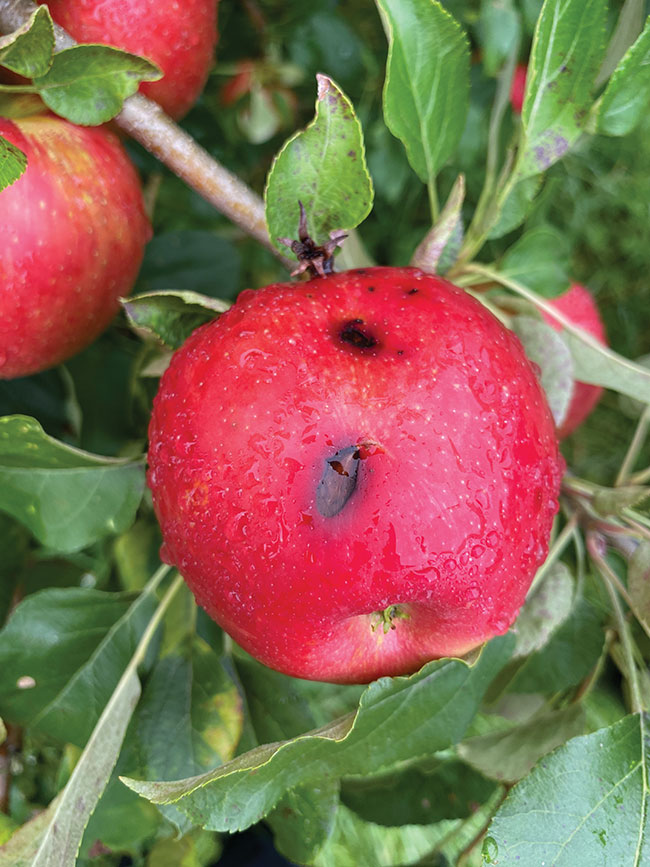
Features
Chemicals
Fruit
Save time with preharvest management
Preharvest practices affect storage success.
February 21, 2024 By Michelle Cortens, tree fruit specialist, Perennia
 A Honeycrisp apple with visible symptoms of black rot infection prior to harvest. Alternatively, a lack of late-season fungicide protection may lead to new infections that are small, go unnoticed, and then progress in storage.
Photo courtesy of Michelle Cortens.
A Honeycrisp apple with visible symptoms of black rot infection prior to harvest. Alternatively, a lack of late-season fungicide protection may lead to new infections that are small, go unnoticed, and then progress in storage.
Photo courtesy of Michelle Cortens. It’s a fact that we cannot go back in time during postharvest storage to cure an issue that originated during preharvest management. Research and technologies have helped to improve longevity in storage, but even the best storage technologies cannot reverse the effects of preharvest issues that cascade into food losses.
The preharvest factors that can mitigate postharvest losses include preharvest management of storage rots and fungi, harvesting at optimum maturity to prevent disorders, and harvest methods that prevent bruising. Of course, the weather has an impact, because we work in natural environments with heavy rain, above-average temperatures, and difficult harvest conditions that each contribute to quality losses that sometimes cannot be avoided.
Yet sometimes, quality losses can be avoided, and knowledge is power. Examining the impact of preharvest management decisions can help to reduce quality losses. Let’s explore which preharvest practices matter for apples, as an example.
In the orchard, fungal spores that land on unprotected apples can germinate, and symptoms will show up as infections in storage. Apple fruit are mainly susceptible to the diseases scab, black rot, flyspeck, sooty blotch and Brooks spot during the preharvest period. When fungicide programs are stopped early, there is an increased risk of diseases showing up in storage if fungicide residues are diluted and no longer provide protection.
Late-season fungicide treatment is especially warranted in blocks that have visible signs of scab infections to help prevent late-season infections that appear in storage as black spots, known as pinpoint scab.
When monitoring for scab infections, check the tops of tall trees that might not have had adequate fungicide coverage. Ambrosia trees, in particular, are very susceptible to scab, and the fruit are stored for a long period of time, which increases the likelihood of symptoms appearing.
Fungicide protection is put to the test during frequent and heavy rain events. In Nova Scotia this year, most of the season’s rainfall occurred during the summer and preharvest period. Agriculture and Agri-Food Canada’s Plant Physiology Program in Kentville, N.S., reports that April through to October saw record-breaking rainfall amounts totalling 915 mm.
Extra rainfall suggests the need for renewed fungicide protection because fungicides are washed off by cumulative rainfall of 25 to 50 mm. Monitor precipitation during harvest, especially for late-season varieties that are exposed to rain wash-off and disease-causing fungi for longer.
Well-timed preharvest fungicides can go a long way to prevent storage rots. Fungicides with short preharvest intervals (PHI) and good activity are especially helpful for protecting apples being placed in long-term storage.
A preharvest fungicide applied as close as possible to storage can provide continued protection from symptom development in storage. Don’t put away the sprayer too early because those late varieties benefit from a preharvest spray, too.
The next step to consider is to harvest at optimum maturity to prevent disorders. Internal browning frequently occurs in overmature and large fruit that have high carbon dioxide concentrations. Overmature fruit are most susceptible because, as fruit mature, they are less able to diffuse internal carbon dioxide concentrations. The internal carbon dioxide builds up and increases the chance of observing internal browning.
If apple growers need more flexibility to harvest fruit at the optimum maturity, they can consider using products that delay harvest maturity.
Finally, during harvest, take the time to educate staff on the proper way to handle fruit. Fruit with bruises and punctures are susceptible to blue and grey moulds, so reducing their incidence can reduce quality losses.
The risk of bruising is lower if staff pick the bottom of the tree first, don’t overfill the picking bag, avoid long harnesses that let the bag bump against their knees when walking, and are informed of delicate varieties. Farms can also re-grade orchard roads prior to harvest to lessen bumps that would jostle fruit being transported in bins.
An inspector can sample fruit from the bins a few times each week to generate feedback for staff. They can leave the apples at room temperature for 24 hours to check for signs of bruise development. Monitoring can help to address any issues early.
Also, note the weather conditions that lead to an increased risk of bruising and adjust practices for varieties sensitive to bruising, if possible. Apples picked after significant rain will bruise more easily than if they’re picked when the soil has a lower moisture capacity. Apples picked in cool weather bruise more easily, and generally, susceptibility to bruising decreases gradually from zero to 15 C.
Furthermore, if bins of fruit will sit in the orchard overnight during freezing temperatures, place the bins where they will be shaded from direct morning sun to avoid rapid thawing that creates deep bruises.
The old adage of an ounce of prevention being worth a pound of cure remains true. Without time travel, we cannot correct the issues showing up in storage that were made during the preharvest period. Remember for next year that preharvest practices to reduce fungi and rots, harvest at optimum maturity, and education to reduce bruising can improve longevity and increase shelf life. •
Print this page